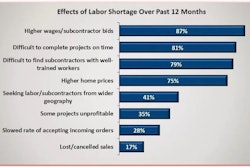
Life on the job site moves very fast. Your workers are tasked with hard labor, tight deadlines, all under less than ideal, and sometimes unsafe, conditions. All the stress that comes with the job can sometimes wear on your people and lead to poor mental health.
Every year depression affects one in every five employees and costs American businesses $210 billion in medical bills and lost productivity. In fact, for every worker with a depressive disorder, a company loses an average of 32 productive workdays per year. Depressed employees are also four to five times more likely to experience work-related problems than employees with chronic physical illnesses like diabetes or heart disease.
This is why it's important to recognize the struggles employees might be going through and equip them with ways to deal with their issues.
What is Resilience Training
Resilience exists when a person can bounce back and thrive from major challenges. It is a key strategy that helps employees tackle stress, a competitive job market and workplace conflicts, all while addressing challenges on the job. Improving resilience is important because employees identify work as the number one stressor in their lives.
Previous research shows that workplace depression and anxiety can be reduced by coaching employees to increase their resilience, the ability to maintain good mental health despite psychological or physical setbacks. In fact, one study found that over a two-month period, a business-initiated resilience program resulted in a significant reduction in presenteeism (employees working while sick), which led to a company gain of $1,846 per person in terms of greater productivity, the journal article says.
So what can you do? Here are a few tips:
- Understand your employees: Resilient employees make resilient organizations. People who are supported, motivated and equipped are best positioned to overcome obstacles and distractions. talk to your your workers about what work-related stressors impact them the most and ask them for suggestions on how to make it better.
- Focus on need: Once you know what employees would like changed, develop a resiliency program around it. Do they need help overcoming difficult work relationship issues? Do they want to focus on managing emotions and remaining calm? Or maybe tips to avoid burn out is what they're looking for. Take a look at the comprehensive report the American Heart Association released examining resilience training in the workplace for a good start.
- Provide resources: It's important for employers to provide access to services and support when needed to maintain good physical and mental health. Sometimes employees require access to a specialist for physical or mental health conditions. Make sure employees are informed about how to access care and that care is available for those who need it. Provide information on resources often.
Total Employee Wellness
As a construction company, you might not consider a wellness program high on your priority list, but maybe you should. Companies should consider wellness programs that give workers a variety of choices, so they can pick the activities that appeal to them, she says. And if a business is going to spend money on a wellness strategy, the company should test it out with a small group of employees first and see if it catches on before launching it to the entire organization.
It’s also crucial for managers to openly express support for wellness initiatives and encourage people to use them and managers should set a good example by taking breaks themselves.
Building a resilient culture begins with a company-wide statement showing support for employees and a commitment to addressing the issue. Start by promoting an open and trusting management style and train managers to understand the importance of supporting the mental well-being of staff. Just making the declaration you want to help isn’t enough. A commitment requires action and regular communication.



















